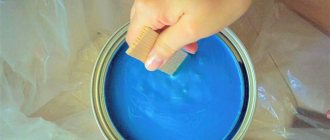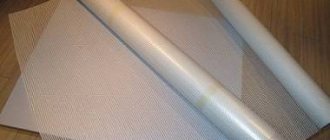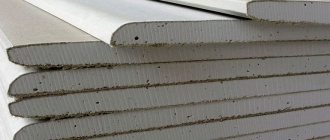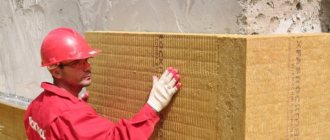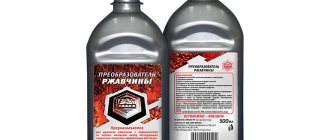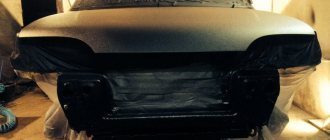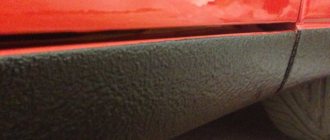Everyone wants to be sure that the car they buy will last a long time. It is difficult to protect yourself from an unscrupulous seller on the secondary market; craftsmen have learned to cope well with restoring broken car parts. This is why when buying a used car, it is important to check whether the factory bodywork has been tampered with.
How can you find out whether the car has been involved in accidents and whether the body has been repaired? Measuring the thickness of the paint coating will show what and where damage the car received when involved in an accident.
If there is straightening (restoration of a deformed shape or individual parts of the body), then a certain amount of putty is necessarily present under the layer of paint. Rotten metal and welds may be hidden. Such information makes it possible to reduce the price or completely abandon an unprofitable purchase.
How to measure the thickness of paintwork? Types of thickness gauges
It’s better not to rely on the eye in this matter, but to buy a special device for measuring the thickness of a car’s paintwork (thickness gauge). It’s better not to skimp and when buying, consider the average price category, then the readings will be more accurate, and the device will last longer.
The devices differ in their operating principles. Conventionally, they are divided into:
1. Magnetic. There is a regular magnet inside the case. The work is based on obtaining data on the force of gravity.
+ cheap;
— significant error in measurements.
2. Electromagnetic. They work on the principle of electromagnetic induction, with a Hall sensor.
+ high accuracy;
- only for iron.
3. Eddy current. The sensor of this thickness gauge contains a transmitting coil that emits radio frequency vibrations. Thanks to this, it is possible to measure the thickness of the paint layer on body elements.
+ measure paintwork on a large number of materials, but best of all on body elements with high conductivity.
+ works without error on aluminum or copper surfaces;
— not an accurate result on conventional hardware;
- High humidity may cause problems.
4. Combined. Here the device has a built-in eddy current sensor for aluminum parts and an electromagnetic one for steel.
+ maximum accuracy in both modes.
5. Ultrasonic. The work is based on the reflection of a signal from a surface. Professional devices for any materials.
+ works accurately on any surface: metal, aluminum, plastic, composite material;
- the most expensive.
When purchasing a thickness gauge, please note that not all models operate at negative air temperatures!
What thickness of paint should be on a car?
If putty and non-factory paint are present, the display will show a significantly larger reading. To evaluate the measurement results, data on the factory paint job of a similar model is required. Here is a table of paintwork thicknesses for passenger cars of various brands: tablica-tolshchin-lakokrasochnogo-pokrytiya.
By checking its data, you can detect broken parts and defects of the body that are hidden from view, without allowing yourself to be deceived. And if the owner did not warn in advance about the detected defect, you have the right to demand a good price reduction.
In Russia, the generally accepted unit of measurement for paintwork thickness is the micron.
1 micron (µm) = 0.001 mm.
1000 microns = 1 mm.
On average, on the body of a new car the layer is from 70 to 165 microns, on the frame - 40-90 microns.
How to use the device
No special skills are required to use the thickness gauge. You can check your car yourself in just a few minutes. But what a headache this simple manipulation will save you from!
Before using the device, it must be calibrated. For this purpose, a special plate is included in the kit. Sometimes the calibration can go wrong, so it's best to check it periodically.
Important! The meter must be applied perpendicular to the body of a clean car and each element must be checked at at least five different points.
Most often, the transition from the original paintwork to the repaired area is a molding, stamping, in general, a place where the part has a relief. A beep sounds and a reading in microns appears on the digital screen. This is the thickness of the paintwork from its top point to the surface of the metal or other material.
How to calibrate a thickness gauge
To give accurate results, the thickness gauge must be calibrated. Calibration gets lost due to temperature changes or if the battery runs out.
To calibrate the thickness gauge, metal plates are used, which are sold with it. If you rent an instrument, ask the owner to calibrate it in front of you and provide you with rental calibration plates just in case.
The calibration plates look like this:
My thickness gauge has two gauge plates because it works on both steel and aluminum parts. The device must be calibrated separately for steel and aluminum. If the thickness gauge only works on one metal, there will be one plate.
The kit usually includes a special calibration film, which is used for adjustment.
The calibration process is simple - place the thickness gauge on the plate and reset the readings to zero:
We apply the calibration film to the plate and place the device on top:
The thickness gauge should show the numbers printed on the film. If this does not happen, repeat the procedure.
The procedure for checking the thickness of a car's paintwork
- It is recommended to start measuring from the roof. It is least susceptible to damage and is a kind of standard. The factory values on most brands are uniform here and slightly lower than in other areas of the car.
- Next, the racks are examined as an indicator of possible side impacts.
- The front and rear parts of the car can also tell a potential buyer a lot, because these are the most vulnerable places in an accident.
- Evaluate the readings on the sills and front doors.
- Wheel arches are the most susceptible to corrosion, which means they are more often subject to repair.
- Next on all remaining external parts of the body.
It is imperative to inspect the paintwork of the interior painted parts of the body. To do this, open all doors, hood, and trunk. The readings there should be less than the external ones.
On cars with original paint, the thickness at some points may vary between 10 and 40 microns. This is due to the painting process on the production line. On machines where individual areas have been repaired, this difference is many times greater.
You should be wary of cases where the vehicle was assembled by someone and completely repainted. It will be difficult to figure it out here, since there is no noticeable difference in the device data between all the parts. The paint thickness table will come in very handy here. After all, with secondary painting, even in a prestigious workshop, and even more so with an ordinary spray gun, it is almost impossible to achieve original indicators.
Why is the paintwork on modern cars so thin?
For comparison, note paper is no more than 76 microns (3 mil) thick. This means that the factory varnish on new cars is thinner than a piece of note paper.
A piece of note paper is thicker than a car's factory clearcoat layer.
The average credit card is about 635–890 microns (25–35 mil) thick (6–9 times thicker than paint).
The thickness of a sheet of carbon paper is about 70 microns (2.8 mil) (about ½ the thickness of paintwork) and is almost one and a half times thicker than the varnish on a car.
Modern paintwork is thin for various reasons. One of them is economic. Manufacturers do not want to waste more paint and varnish than required. The layer is made thick enough to protect the body and thin enough to reduce the cost of production.
Little paint is also applied due to the reduction of environmental pollution. In addition, many factories now use water-soluble paints, which are capable of applying more pigment in one layer than conventional ones. Conventional paints require 4-6 thin coats with drying in between.
Ultrasonic thickness gauge UT-1
What device values indicate additional layers and repairs?
It is best to write down the results of measurements for individual parts and, in case of suspicion, display the arithmetic average for the entire car. Then, comparing this reading according to the table, you will clearly notice that there is a discrepancy with the thickness of the factory layer. The results of measurements that indicate interference with the factory coating:
- the device shows 600-800 microns - the car has definitely been painted, perhaps more than once; more than 1000 microns also means a thick layer of putty;
- a value below the factory value means that minor local damage has been repaired by polishing;
- if the numbers “dance” greatly from section to section, then the part was restored after an accident;
The fact of intervention is indicated by exceeding the table data by 50-90 microns. A minor repair will result in a deviation from the norm of 50-150 microns. Repainting is indicated by differences of local areas from the average indicators for the body by 40%. The difference with the table is within 10 microns. is considered acceptable.
If the measurement consistently exceeds the table readings, and the owner insists that the car has not been repainted, then the optimal solution would be to double-check the data on the same model, same year of manufacture.
Factors affecting coating thickness
There are quite a few such factors: place of assembly, year of manufacture, frequency of washing the car, and even removing snow with a brush. Modern polishings and nano-coatings do not significantly affect the thickness of the paintwork, but films, whether protective, carbon or matting, increase the readings of the device by 100 - 200 microns.
In the auto market, every second car has undergone a painting procedure. The reason for this could be simple scratches or global damage. Light defects do not greatly affect the market value. But if the element was seriously damaged, buying such cars is not only unprofitable, but may not be safe. Timely determination of these facts allows you to reduce the cost of a used car by tens of thousands, so thorough preparation for examining the body pays off in full.
Use all the listed nuances and criteria, have a table of car paint thickness on hand and your purchase will be successful.
Essence of the question
Almost all experienced car enthusiasts know that the thickness of paintwork varies by car brand.
Of course, it is better to buy a car that is more or less new, but the budget does not always allow this. In this case, the search for a suitable copy can turn into a lottery. The same situation can happen when you start looking for an expensive model in the lower price range on the used market. A list of the best options for used cars under 400,000 rubles can help to some extent, but not in assessing the condition of the body and its coating.
A separate group of buyers can be identified as those who want a certain car due to some kind of attachment, for example, BMW. Here you will have to keep your eyes open, because crime, corrosion, and multiple repairs are possible. Examination of the paint layer can tell the future owner a lot:
- Was the car involved in the accident?
- What kind of damage did you receive in the accident?
- How were the body or coating defects eliminated?
- How much can you reduce the price of a car when bargaining?
